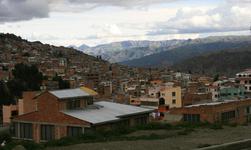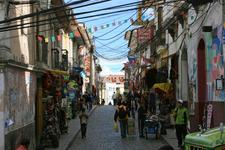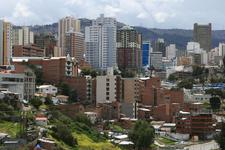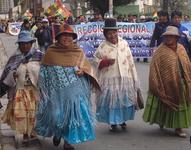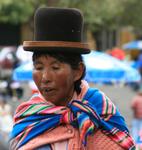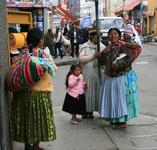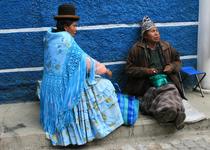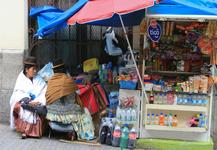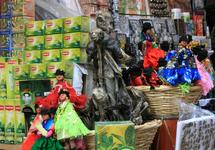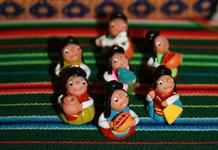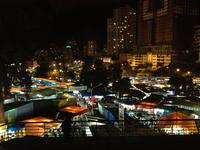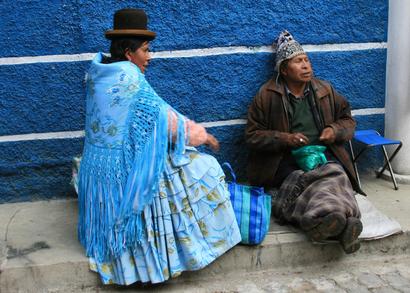
Nuestra Señora de La Paz (Our Lady of Peace). This is the full name of the true capital of Bolivia. Officially the country’s capital is Sucre yet the seats of government are in La Paz and, from what we have learnt, here is the heart of this country.
We have visited La Paz four years ago for the first time and we didn’t like it then. This time we decided to give it a second chance. We had the first glimpse of this metropolis when entering it from the south. It is a panoramic view on thousands of houses built so close to each other that from a distance they look like favelas (the poor neighbourhoods) in Rio de Janeiro. But those are not favelas. This is how most people live there.
Our first day was a chilled-out one, but the evening was entertaining. The host we stayed with – a German girl named Dunja – took us to the biggest bazaar in the city called Alasitas. It is a huge fair with thousands of stalls where you can buy everything from food, clothes, telephones, souvenirs and toys, through tokens for a mini-hazard games, to wedding rings (looking almost like the gold ones) and veils that came together with a certificate confirming that you have just got married. All in all it looked like a mini Las Vegas Bolivian style.
However, it is not the wedding rings that made Alasitas so popular. It is an Aymara tradition coming from the times when farmers prayed to the god of abundance named Ekkekko and offered him part of their crops so that he would bring them more in the coming year. Nowadays, the tradition changed in the urban areas into buying everything in miniature and offering it to Ekkekko with the hope that what you offer in mini-size will appear in your life in full blast. So, if you buy a nice little figure of a house or a car, one day you will have a real one. Or better, if you get a pile of Monopoly-size money, you should expect a big fortune in the future. We’ve bought a few small figures of Bolivian Cholitas, that is women dressed in traditional clothes (including the famous Bolivian bowler hat looking like the ones Englishmen wear in Great Britain) and I hope that they will NOT be waiting for us at our door when we come back to Warsaw!
Life in La Paz doesn’t seem easy as it’s a vast city situated at 3600 m. The traffic is very heavy and most of the streets go up or down so when visiting it on foot it’s worth checking if the road you want to take as a shortcut goes up or down the hill. Otherwise, you’ll lose your breath quite quickly.
On the city-tour we did with Jack (an Australian guy who fell in love with a Bolivian girl and decided to change the waves of the Pacific Ocean to Bolivian heights) we’ve heard about another way of living in La Paz. That is in the San Pedro Prison. Well, it seems that this is a country within the country. After crossing the prison’s gate people who are sentenced there need to make quite an effort to survive. First of all, they need to buy their own cell to have a place to stay for all the years they are there for. Secondly, they need to take care about the food during their time in prison. If they don’t have money to do that they can work by washing dishes, cleaning other cells, making laundry or… producing cocaine. Rumor has it that the best cocaine in the whole Bolivia comes from the San Pedro Prison in La Paz. A question occurs how this is possible!?! It comes with another rule applied in this jail, which allows the families of the convicted to live with them in their cells. Unbelievable as it may seem, the wives and children are also staying in the prison permanently. Yet, there is a “slight” difference concerning their lives there. They can go out to work or to attend school! In this reality it’s easy to imagine that smuggling anything into and out of the prison would not be impossible. In the worst case a bit difficult.
This time La Paz made a positive impression on us. It’s hard to say whether it was because the city has changed so much during those four years or due to the fact that we’ve got more familiar and more accustomed to the Latin-American culture after almost three months of travelling the continent. It is definitely a very lively city full of contrasts where tradition is mixed with modernity. It is not uncommon to see a woman dressed in traditional Bolivian clothes (a Cholita) walking with her teenage son who’s wearing Nike shoes, Levi’s jeans, FC Barcelona t-shirt and has white earphones stuck in his ears. It is also frequent to see an old bazaar with amulets and dried animals next to the modern store selling North Face trekking clothes and Lonely Planet guides.
